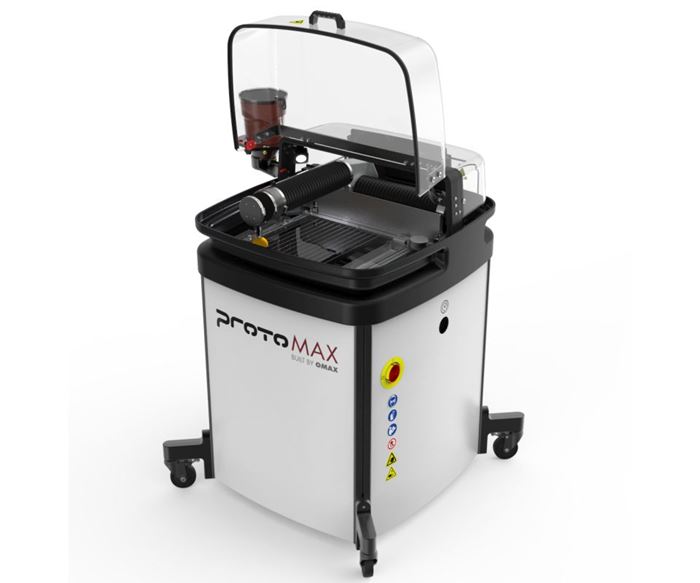The Personal Waterjet Cutting System Is a Natural Development
Much like what is happening with desktop 3D printing, Omax has developed a way to bring the versatility, capability and simplicity of waterjet cutting to a broader spectrum of users.
Perhaps no other material cutting process is as versatile, capable and simple as abrasive waterjet cutting. These qualities have made it a favorite for industrial users such as job shops and fabricators as well as for mobile repair centers, engineering classrooms, art studios and design houses. In an effort to make the technology even more versatile, Omax has now announced the release of a personal waterjet cutting system called the ProtoMax.
This system promises to make waterjet cutting feasible for a broad class of users for which versatility, capability, simplicity (and now affordability) are especially important. This group includes inventors, artists, teachers, engineers, prototypers, hobbyists, crafters and industrial users who need occasional waterjet capabilities to complement other cutting systems. The ProtoMax would not be out of place in a household setting. In fact, many of the same types of users who have already embraced various 3D printing and additive manufacturing processes in the maker movement are likely to take note of this new system.
Omax describes the new waterjet as a compact, self-installed cutting system suited for prototyping and relatively low-volume cutting of almost any material less than 2 inches thick in two-dimensional contouring. Aluminum, steel, composites, rubber, glass, granite, plastics, wood and other materials can be cut under the 30,000-psi cutting nozzle powered by a 5-hp pump. The maximum workpiece size is 12 inches by 12 inches. Abrasive waterjet cutting does not create a heat-affected zone, does not change material properties, creates little mist, and is relatively quiet at 76 decibels when cutting under water (about the same noise level as a garbage disposal or dishwasher). Other specs given for the ProtoMax include ±0.005-inch linear positioning accuracy, ±0.003-inch repeatability and a maximum 100-ipm traverse speed.
The system accepts the same garnet powder used in full-scale industrial systems. Because the garnet powder is available in proportionately smaller quantities appropriate for a unit of this size, the price per pound is somewhat higher. The hopper of the unit holds 14 pounds of powder. The lower stream pressure of the new system does reduce cutting speed compared to full-size machines, but this does not seem an obstacle for projects that fit the cutting table of the personal system.
The new waterjet plugs into a three-prong, 240-volt AC outlet such as one used for a home clothes dryer. The pump and cutting table are on casters, enabling the unit to be rolled into place.
As is the case for industrial models of abrasive waterjet cutting machines, programming software and the unit’s computer control system largely determine how readily the process can be implemented. For the ProtoMax, part programming and cutting operations are controlled by the company’s proprietary Intelli-Max software. According to Stephen Bruner, VP of marketing, the ProtoMax programming and control software are based on the same CAD/CAM software features of the industrial version. These features include waterjet cutting models that predict the behavior when cutting different materials, thicknesses and shapes. The user interface is said to be straightforward and appropriate for learning computer-aided manufacturing.
Mr. Bruner also notes that whereas most small industrial waterjets start at $70,000, the ProtoMax has a unit list price of $19,950.
Omax has launched a website to provide additional information about the personal waterjet system and purchasing options. The site includes design ideas, detailed specifications, frequently asked questions and a community section to support users and fellow enthusiasts. The first units are expected to be shipped by the end of 2017.
Related Content
How to Start a Swiss Machining Department From Scratch
When Shamrock Precision needed to cut production time of its bread-and-butter parts in half, it turned to a new type of machine tool and a new CAM system. Here’s how the company succeeded, despite the newness of it all.
Read More10 Things to Know About Creep-Feed Grinding
Because of the high material removal rate creep-feed grinding can deliver in challenging materials, grinding might not be just the last step in the process—it might be the process.
Read MoreChoosing The Right Grinding Wheel
Understanding grinding wheel fundamentals will help you choose the right wheel for the job.
Read MoreWatchmaking: A Machinist’s View
Old-world craftsmanship combines with precision machining on a vertical machining center and Swiss-type lathe to produce some of the only U.S.-made mechanical wristwatch movements.
Read MoreRead Next
The Cut Scene: The Finer Details of Large-Format Machining
Small details and features can have an outsized impact on large parts, such as Barbco’s collapsible utility drill head.
Read More3 Mistakes That Cause CNC Programs to Fail
Despite enhancements to manufacturing technology, there are still issues today that can cause programs to fail. These failures can cause lost time, scrapped parts, damaged machines and even injured operators.
Read More














.png;maxWidth=300;quality=90)



.png;maxWidth=300;quality=90)









